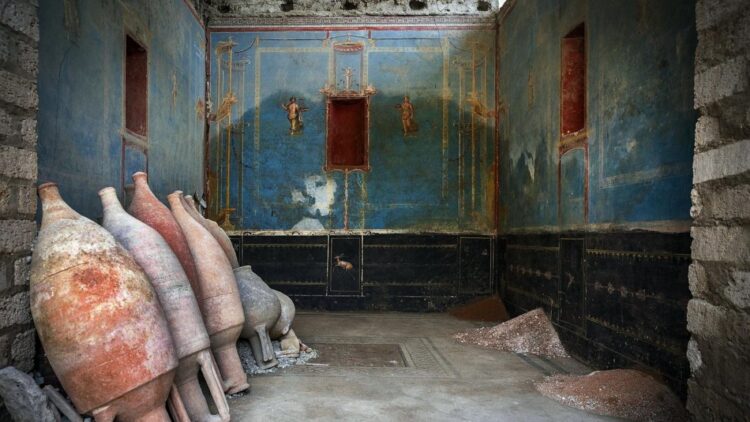The other one is Pompeii, the city that was buried under the ashes of the volcanic eruption of Mount Vesuvius in 79 AD, and it still has more to tell. Last year, there was a sensational find of a ‘blue room’ that had the potential to revolutionise the knowledge of Roman art and aesthetics. This discovery is waiting to turn history books bright with its color that is as scarce as striking.
A rare and expensive color: the significance of blue in Roman times
The newly discovered blue room in Pompeii is quite interesting because blue was a very scarce color in the Roman period. Blue was problematic because the pigments used had to be imported from afield, such as Egypt and the eastern Mediterranean. This made blue a luxury; they only used it where they wanted to make a statement: that the product was expensive and could only be afforded by the richest of the rich.
The size of the room is about 90 sq ft with blue paint, and the walls are decorated with women and agricultural motifs. For this reason, the murals depict both the seasons and elements of farming. This shows that the room may have been used as a sacrarium, a room for ritual activities, and the keeping of ritual paraphernalia.
The finding of this blue room gives people insights into the material prosperity of the Roman elite and their business relations and imports. The fact that such an expensive pigment was used speaks to the significance of the room and the part it played in the daily social and religious existence of the people of Pompeii.
The artistry and symbolism of the blue room’s murals
The blue room, concerning its color and artwork, is very important and contains detailed artwork with meanings. Some scholars think that the female characters painted on the walls can be identified with the four seasons, which is typical for Roman art and denotes the flow of time and life cycle. The other murals depict symbols associated with farming and rearing of stock, in the form of a plough and a shepherd’s staff, implying that Romans attached much value to farming and animal rearing.
These artistic elements suggest that the room served a dual purpose, which also became a part of religious activities and the owner’s ability to demonstrate their material success and erudition. They could also be associated with the symbolic significance of colors, which must have been quite apparent for those insiders who were well-versed with the color code of the social structure; the beauty and costly look of the blue walls are bound to pamper and overcome the travelers arriving at the palace.
This identification also provides information about the methods employed by Roman artists. The richness of the color was done by adding Egyptian blue, the first synthetic pigment ever created by man. This pigment was extracted by melting the sand, copper, and natron to form a glass-like substance with blue crystals. This pigment’s display of the intricacy of the process of its manufacture and application reflects the high degree of Roman craft mastery.
The broader implications of the blue room discovery
The blue room dig is part of a more significant campaign to restore and study the richness of the Pompeii ruins. Pompeii has more than 13,000 rooms in 1,070 apartments where the Middle and Upper classes of the ancient Romans lived, worked, and even died. Every one of them – from the blue room to other recently discovered wonders – contributes somehow to our understanding of this incredible city and questions what we used to know about it.
A place like the Blue Room still exists, which is why there is a need to continue with more excavations in Pompeii. Still, to this day, the site remains a gold mine of discoveries that enthrall laypeople and academics alike even to this day, as it has been almost 2000 years since the site was buried. These and other artifacts can still be preserved with care, and their study is the primary key to reconstructing the history of the city and the entire Roman Empire.
While working with other objects found on the territory of Pompeii and studying the newly explored areas, the blue room remains an example of the highly developed artistic culture of ancient settlements. The brightness of the color and masterly performed murals trace the historical background of Rome and show that it was not a simple society.
The blue room in Pompeii is a recent archeological find that will doubtless revolutionize the perception of Roman art and culture. The colour of the object is very rare and expensive. Together with the murals and the symbolism of the object, it underlines the richness and the high status of the owners. As more research is done and more of Pompeii is uncovered, the blue room stands testament to the history of the city and the need for future archaeology.

